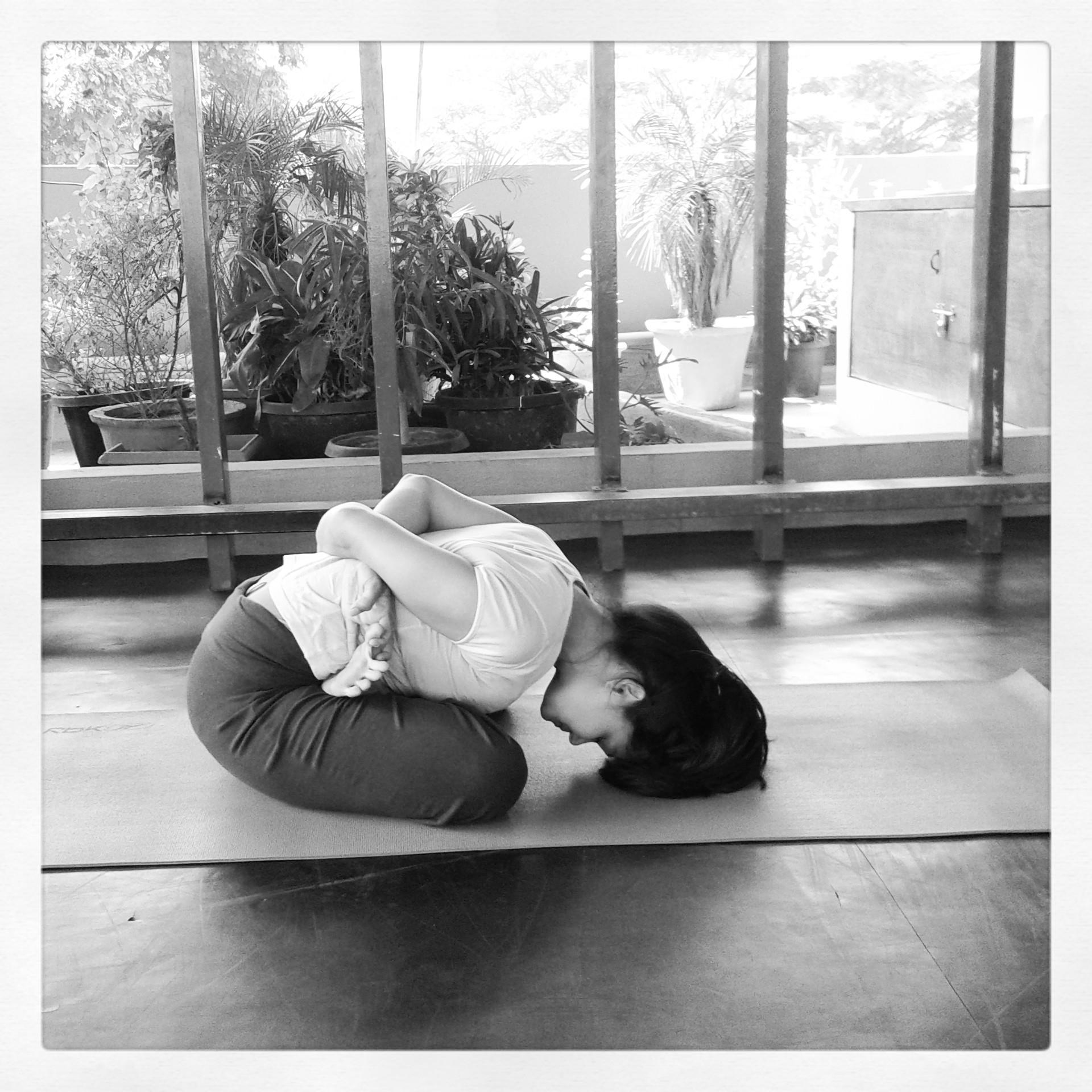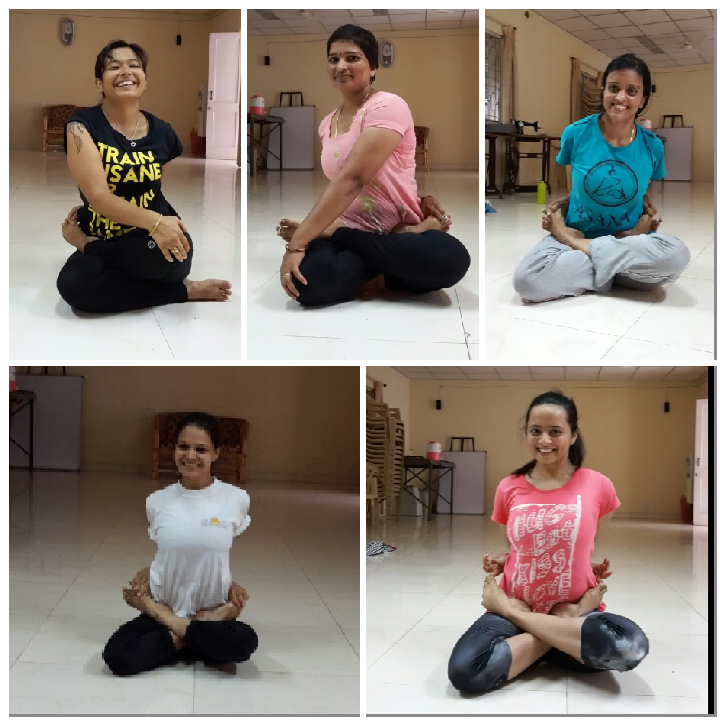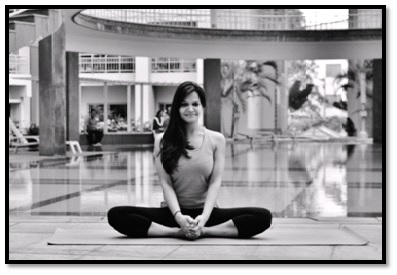I’ve been sleeping so much during the day that I’m unable to fall asleep in the night. When I finally fell asleep last night it was after 12 and I only got 4 hours of sleep. The funny thing is that I was still able to give a 100% during class. I didn’t feel fatigued or tired. Plus, I got there early enough to not have to place my mat right in front of the door!!! I pushed myself through the 20 Surya Namaskars, practiced the Pada Hastasana (from yesterday). As if on cue, Saraswati appeared to guide me through the Utthita Trikonasana (Triangle Pose), Utthita Parsvakonasana (Side Angle Pose), Prasarita Padottanasana (Wide Legged Standing Forward Bend), and the Parsvottansana (Intense Side Stretch). I’m glad we’re not doing more than an asana a day! During the practice a lot of questions fill my mind. The style of teaching here is very different from what I’m used to. In my Iyengar class we pay minute attention to detail. Here we focus on breath. There we use props, here the most I’ve seen people use is a yoga towel. There the teacher demonstrates, here the cues are all verbal. There the instructions are detailed and very specific, here the cues are not even complete sentences. The differences are more than I can verbalize, but the interesting thing is that these differences don’t dim my enthusiasm for the classes. I’m still eager to learn and internalize and haven’t dismissed this style as ‘not for me’. I’ve read in other blogs that there is an energy and a power in this place that transfixes you. Maybe I’m under the spell?
And truth be told, I’m kind of surprised at my approach to this class. I’m sort of a type A personality. There are always a million books to be read and many more to be written. There are 840,000 asanas to be learnt! My practice barely scratches the surface. However, here at ‘the source’ of Ashtanga yoga, I’m completely laid back. I only practice once a day, I’m hardly reading about the practice and philosophy, and I’m not even badgering the teacher to teach me MORE. I’m kind of allowing the teacher to set the pace for me. And today, post the Savasana, when I heard another student asking Saraswati to teach him specific asanas he was interested in, I realized what was the matter with me.
I believe a yoga teacher is a yoga student too. And a good student is a good teacher. I’ve noticed that over the years I have become intensely selective about the yoga classes/workshops I attend. If my heart is not in it, I won’t go. The teacher may have a large following and might have a million publications. The teacher may have huge hoardings all over the city and lots of endorsements. However, I will only go to a teacher who I feel a sense of grounding with. A sense of living in this world in spite of the problems, and not as a means of escaping from the problems that plague our world. And over the years I feel I’ve managed to ‘hear’ such teachers out and I’ve tuned out the rest of the din. And I’ve tried to cultivate a practice which rings true with me, under the tutelage of all the teachers who I resonate with. After all, if you want to build something, the most important thing you need is a strong foundation. So perhaps it is with this mind-set that I came here. I know all these teachers are experienced and reputed. I’ve read a lot about the lineage and the method (although I’ve discounted stories about how ‘power’ and the ‘energy’ and the ‘vibe’ because that’s purely subjective). And when I finally applied to practice here, I came as a student would come to a guru. For guidance. Because I don’t ‘try’ teachers or ‘experiment’ with teachings, I feel that when I go to a teacher I’m open and receptive. I feel that it is not for me to question the teacher or to tell the teacher what they should tell me. As a student I listen a lot and I will do whatever the teacher asks of me. As a thinking person I sift through what the teacher has imparted. Some things I retain and incorporate into my personal practice, while others I retain as philosophies that also exist. I’ve read somewhere that a student has to surrender completely to a guru. I think that makes sense to me now. When I go to Saraswati’s class I’m just a student awaiting guidance. She has been teaching for long enough to be able to observe a student and guide her accordingly.
Also, at some level I feel that if you bring the ‘I’ to a teacher, then you are at some level obliterating the teacher. And that’s a pretty valuable thing to obliterate. Which is why I don’t go to teachers to tell them that I can do so and so asanas. A good teacher can tell. In fact, a good teacher will make you realize that you can do even that which you weren’t aware you already could.


![1[1]](https://yogawithpragya.com/wp-content/uploads/2015/12/11-1.jpg)
![POMELO_20151130105401_save[1]](https://yogawithpragya.com/wp-content/uploads/2015/11/pomelo_20151130105401_save1-1.jpg?w=300) what lay ahead. I made it to Mysore on time and managed to find KPJAYI easily. Basically everyone seemed to know where it was. There were throngs of people who were already there before me to register. Registrations for the advanced class had started, and I had to
what lay ahead. I made it to Mysore on time and managed to find KPJAYI easily. Basically everyone seemed to know where it was. There were throngs of people who were already there before me to register. Registrations for the advanced class had started, and I had to ![POMELO_20151130201506_save[1]](https://yogawithpragya.com/wp-content/uploads/2015/11/pomelo_20151130201506_save1-1.jpg?w=169) wait a while before I could register for Saraswati’s beginners’ class. I joined a queue of people who had never practiced Ashtanga before. We sat on the cool marble floor of the office and shared our pens to fill out our registration forms. People have come here from far and wide. Some have even brought children along!
wait a while before I could register for Saraswati’s beginners’ class. I joined a queue of people who had never practiced Ashtanga before. We sat on the cool marble floor of the office and shared our pens to fill out our registration forms. People have come here from far and wide. Some have even brought children along!![POMELO_20151130201250_save[1]](https://yogawithpragya.com/wp-content/uploads/2015/11/pomelo_20151130201250_save1-1.jpg?w=300) time before heading out again for an early dinner. I managed to find a place. Wasn’t too happy with the coffee nor the organic ‘sprouded’ moong dal dosa. I want masala dosas!!! Hopefully I’ll be able to find a place which serves strong filter coffee and masala dosas a la Adigas.
time before heading out again for an early dinner. I managed to find a place. Wasn’t too happy with the coffee nor the organic ‘sprouded’ moong dal dosa. I want masala dosas!!! Hopefully I’ll be able to find a place which serves strong filter coffee and masala dosas a la Adigas.![POMELO_20151130184201_save[1]](https://yogawithpragya.com/wp-content/uploads/2015/11/pomelo_20151130184201_save1-1.jpg?w=200)
![20151129_200421[1]](https://yogawithpragya.com/wp-content/uploads/2015/11/20151129_2004211-1.jpg?w=300)
![POMELO_20151129154114_save[1]](https://yogawithpragya.com/wp-content/uploads/2015/11/pomelo_20151129154114_save1-1.jpg?w=300)
![POMELO_20151129204651_save[1]](https://yogawithpragya.com/wp-content/uploads/2015/11/pomelo_20151129204651_save1-1.jpg?w=300)

![20150914_133352_-1575466813[1]](https://yogawithpragya.com/wp-content/uploads/2015/09/20150914_133352_-15754668131-1.jpg?w=84)
![20150914_133449_570824101[1]](https://yogawithpragya.com/wp-content/uploads/2015/09/20150914_133449_5708241011-1.jpg?w=84)
![20150914_133531_2052623839[1]](https://yogawithpragya.com/wp-content/uploads/2015/09/20150914_133531_20526238391-1.jpg?w=84)
![20150914_133832_920563252[1]](https://yogawithpragya.com/wp-content/uploads/2015/09/20150914_133832_9205632521-1.jpg?w=84)
![20150914_134000_193050774[1]](https://yogawithpragya.com/wp-content/uploads/2015/09/20150914_134000_1930507741-1.jpg?w=84)
![20150914_134212_-1596057775[1]](https://yogawithpragya.com/wp-content/uploads/2015/09/20150914_134212_-15960577751-1.jpg?w=84)
![20150914_134613_157411077[1]](https://yogawithpragya.com/wp-content/uploads/2015/09/20150914_134613_1574110771-1.jpg?w=84)
![20150914_134731_1622070687[1]](https://yogawithpragya.com/wp-content/uploads/2015/09/20150914_134731_16220706871-1.jpg?w=84)
![Photo Collage Maker_1CTZOu[1]](https://yogawithpragya.com/wp-content/uploads/2015/09/photo-collage-maker_1ctzou1-1.png?w=300)